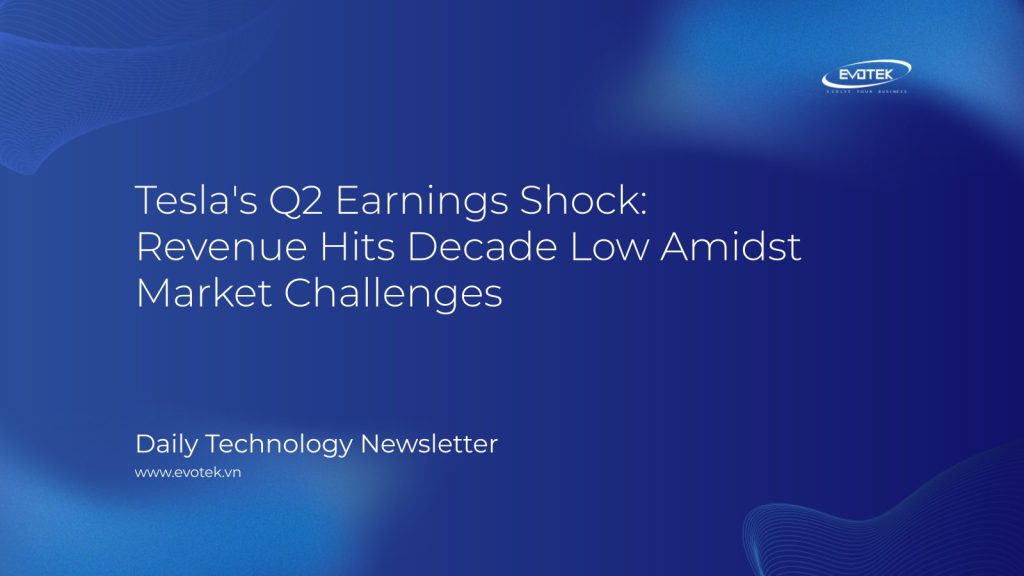Tesla’s second-quarter 2025 financial results reveal a significant downturn, marking the largest revenue drop in years and raising questions about the company’s trajectory amidst various internal and external pressures.
The electric vehicle manufacturer reported a net income of $1.17 billion on revenues totaling $22.5 billion for Q2. While this figure slightly surpassed Wall Street’s $22.3 billion expectation, it represents a notable 12 percent year-over-year decrease compared to the $25.5 billion recorded in Q2 2024.
Profitability also experienced a sharp decline, with a 16 percent year-over-year reduction in net income. Furthermore, Tesla’s core automotive revenue, derived directly from vehicle sales, plunged by 16.6 percent, falling from $19.9 billion in Q2 2024 to $16.6 billion in the most recent quarter. A crucial lifeline, the sale of $439 million in regulatory credits, once again bolstered Tesla’s finances. However, this revenue stream is projected to diminish rapidly following congressional approval of President Donald Trump’s plan to eliminate fines for automakers exceeding fuel-efficiency targets.
This financial slump follows a challenging quarter for vehicle deliveries. Tesla announced a total of 384,122 vehicles delivered, a 14 percent drop compared to Q2 2024, signaling a direct impact on sales performance for the direct-to-consumer company.
Operating income for Tesla saw a dramatic 42 percent year-over-year decrease, dipping below $1 billion. Nearly half of this operating income was supported by the aforementioned sale of regulatory credits, a revenue source expected to virtually disappear in the coming months. The company’s cash reserves also dwindled by $200 million in Q2, settling at $36.8 billion. Free cash flow, a key indicator of a company’s financial health, stood at a mere $100 million. Analysts are now expressing concern that Tesla’s free cash flow could turn negative later in the year, a scenario that could trigger a significant drop in its share price.
Looking ahead, Tesla stated it completed “first builds of a more affordable model in June,” with volume production targeted for the latter half of 2025. These anticipated models are understood to be cost-optimized versions of the existing Model 3 and Model Y, rather than an entirely new vehicle platform, which had been a hope for many investors. The company also confirmed ongoing development of the Tesla Semi and Cybercab, both slated for volume production in 2026.
In its report, Tesla alluded to economic uncertainties stemming from the Trump administration’s trade policies, as well as evolving “political sentiment” that has reportedly made its brand less appealing to some customers. Notably, the company’s official explanation for the revenue decline focused on falling sales, reduced regulatory credit revenue, a lower average vehicle selling price, and a decline in energy generation and storage revenue, omitting direct mention of political factors or CEO Elon Musk’s growing unpopularity.
After a period of extraordinary growth, Tesla’s sudden reversal of fortunes has left many investors and supporters reeling. The company now serves as a stark reminder of the risks when a leading enterprise, particularly one with a high-profile CEO, appears to be operating on “autopilot” while its leader pursues highly visible and sometimes controversial ventures outside of core business.
Elon Musk has publicly stepped back from his controversial role as head of DOGE, a Trump administration initiative focused on federal government cost-cutting. Despite his recent public disagreements with Trump, Musk’s political engagement continues. Earlier this month, he announced plans to establish a new political entity, “the America Party,” fulfilling a previous threat to challenge Republicans who supported Trump’s budget bill.
As Musk deepens his involvement in politics, investors have increasingly urged him to prioritize Tesla’s core operations and its substantial investments in self-driving technology and humanoid robots. Tesla launched its initial robotaxi service in Austin, Texas, last month, though the rollout fell short of Musk’s earlier grand predictions. The service was restricted to a select group of pro-Tesla influencers, and each vehicle operated with a safety monitor in the passenger seat equipped with a kill switch.
While Musk aims to direct investor attention towards Tesla’s advancements in AI and autonomous driving, the company’s primary business remains the manufacturing and sale of vehicles. The competitive landscape is intensifying in markets like China and Europe, and in the US, federal incentives that significantly reduce the price of most EVs are set to expire by the end of September, again due to the Trump administration’s legislative actions. This expiration is predicted to further depress Tesla’s sales.
In response to its demand challenges, Tesla has leaned heavily on promotions. The automaker has recently rolled out various discounts and financing incentives across its model lineup, seeking to capitalize on what may be its final strong sales quarter this fall.

 日本語
日本語 한국어
한국어 Tiếng Việt
Tiếng Việt 简体中文
简体中文